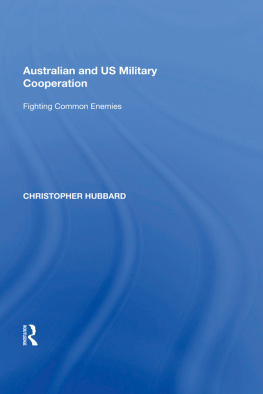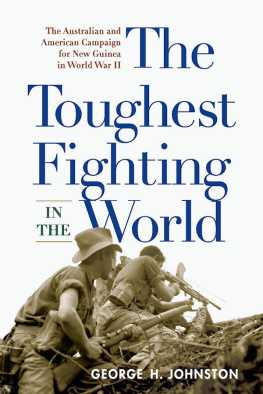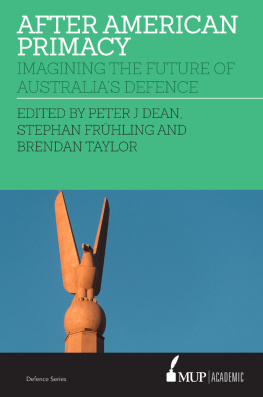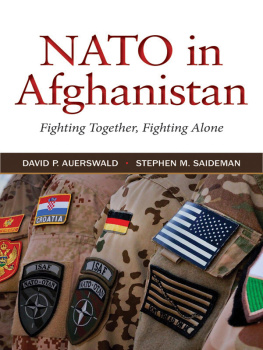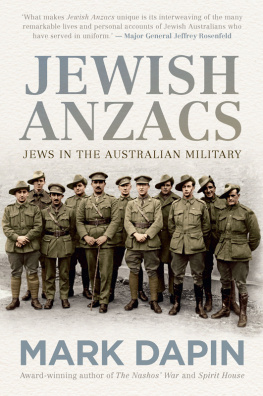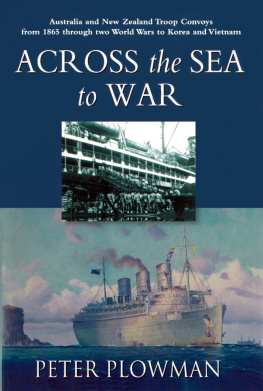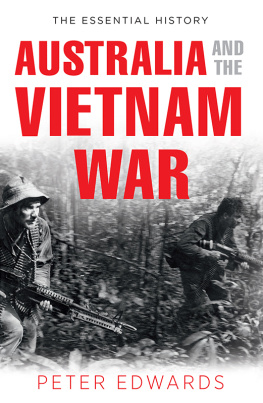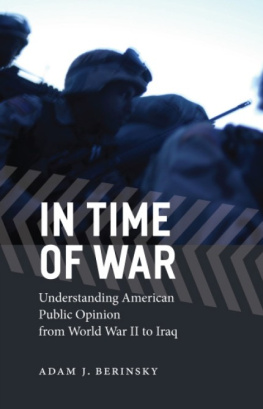Australian and US Military Cooperation
In memory of my Father
Australian and US Military Cooperation
Fighting Common Enemies
CHRISTOPHER HUBBARD
Curtin University of Technology, Australia
First published 2005 by Ashgate Publishing
Reissued 2018 by Routledge
2 Park Square, Milton Park, Abingdon, Oxon OX14 4RN
711 Third Avenue, New York, NY 10017, USA
Routledge is an imprint of the Taylor & Francis Group, an informa business
Christopher Hubbard 2005
Christopher Hubbard has asserted his right under the Copyright, Designs and Patents Act, 1988, to be identified as the author of this work
All rights reserved. No part of this book may be reprinted or reproduced or utilised in any form or by any electronic, mechanical, or other means, now known or hereafter invented, including photocopying and recording, or in any information storage or retrieval system, without permission in writing from the publishers.
A Library of Congress record exists under LC control number: 2005005528
Notice:
Product or corporate names may be trademarks or registered trademarks, and are used only for identification and explanation without intent to infringe.
Publisher's Note
The publisher has gone to great lengths to ensure the quality of this reprint but points out that some imperfections in the original copies may be apparent.
Disclaimer
The publisher has made every effort to trace copyright holders and welcomes correspondence from those they have been unable to contact.
ISBN 13: 978-0-815-38768-8 (hbk)
ISBN 13: 978-1-351-16284-5 (ebk)
| 1ATF | First Australian Task Force |
| AAEC | Australian Atomic Energy Commission |
| AATTV | Australian Army Training Team Vietnam |
| ABCA | America, Britain, Canada, Australia Armies Program |
| ADF | Australian Defence Force |
| AEW | Airborne Early Warning |
| ANSTO | Australian Nuclear Science and Technology Organisation |
| ANZAM | Australia New Zealand and Malaya defence arrangements |
| ANZUS | Australia New Zealand and the United States military alliance |
| APEC | Asia-Pacific Economic Cooperation |
| ARF | ASEAN Regional Forum |
| ARPANSA | Australian Radiation Protection and Nuclear Safety Agency |
| ASEAN | Association of Southeast Asian Nations |
| ASNO | Australian Safeguards and Non-proliferation Office |
| AUSMIN | ANZUS Ministerial Talks |
| CTBT | Comprehensive Test Ban Treaty |
| FTA | Free Trade Agreement |
| IAEA | International Atomic Energy Agency |
| ICBM | Intercontinental Ballistic Missile |
| INTERFET | United Nations International Force East Timor |
| MAAG | United States Military Assistance and Advisory Group |
| MACV | United States Military Assistance Command Vietnam |
| MD | United States Missile Defense Program |
| NATO | North Atlantic Treaty Organisation |
| NMS | United States National Military Strategy |
| NPT | Nuclear Non-proliferation Treaty |
| RAR | Royal Australian Regiment |
| RMA | Revolution in Military Affairs |
| SEATO | South East Asia Treaty Organisation |
| TNI | Indonesian Armed Forces |
| UKUSA | United Kingdom United States Australia intelligence treaty |
| UNSCOM | United Nations Special Commission |
| UNMOVIC | United Nations Monitoring, Verification and Inspection Commission |
| USMC | United States Marine Corps |
| WMD | Weapons of Mass Destruction |
Chapter 1
Introduction
The aim of this book is to examine the origins, evolution, significance and future of the military alliance between the United States and Australia known universally as 'ANZUS'. This alliance, in the absence since 1986 of New Zealand, consists of only these two mismatched Pacific powers - one the single remaining global superpower, the other a self-proclaimed 'middle power' and increasingly a South Pacific hegemon - and it has now endured for over half a century. That period has been marked by enormous and rapid change in almost every aspect of the lives of the citizens of both countries, and of relations between nation states generally. The trans-Pacific pact's wider significance has been increasingly visible in the strategic policy directions of both nations in respect of the national security and well-being of their people. Furthermore, the significance of ANZUS extends well beyond the arena of military defence and security, to encompass a wide array of political, geopolitical, economic, social and cultural questions of concern to both nations. From this perspective, the military security alliance between the US and Australia is one of the most concrete expression (now joined by the 2004 Australia/United States Free Trade Agreement) of a much wider relationship of mutual respect, cooperation and national interests reaching back to the Second World War and, either directly or indirectly, into the lives and aspirations of many member of both societies.
Within the broad sweep of relations between the two nation states, this study develops images of the armed forces of the United States and Australia over the past fifty years as they stood shoulder-to-shoulder on the battlefields of the world. In conflicts in the South West Pacific during World War II and later in the Korean peninsula, and then from Vietnam to Afghanistan and on to Iraq, Australia's and America's armed forces have repeatedly found themselves engaging common enemies. From the perspective, then, of security cooperation, the true meaning of their military alliance has gained lasting significance in the reality of dangers faced and goals successfully attained through cooperative effort.
This is not to suggest, however, that the relationship has been devoid of concerns or potential for dispute. For over fifty years, the Australian and American peoples and their governments have largely taken for granted the fact that, when the going gets rough, each can count on the other for support, whether military, diplomatic or otherwise. The history of their relationship indicates that this assumption has been affirmed over that time, although sometimes in distinctive and unbalanced ways. Nevertheless, the complexity and potential vulnerability of the ANZUS alliance belies the often complacent attitudes of agenda setters and decision makers in both Canberra and Washington over matters of mutual interest.
In this context, the crisis in ANZUS which erupted in 1985 over the New Zealand Lange government's refusal to allow United States nuclear powered or armed warships entry into New Zealand ports served to highlight the potential fragility of the pact. The story of New Zealand's somewhat accidental decision to declare itself a de facto non-nuclear state, in direct contravention of the substance of its US alliance, is one with unique political and social resonance for the New Zealanders. There would, in addition, have been little comfort for New Zealand from the knowledge that Australia had also imposed a ban on the visit of nuclearpowered warships on safety grounds from 1971 to 1976, but with no discernible effect on the relationship. The later episode also had a significant impact on the remaining alliance relationship between the US and Australia, and its short and medium term effects in this context will be discussed in Chapter Seven. ANZUS, of serious concern to the United States but vitally important to Australia's security strategy, was thereby transformed from a trilateral to a bilateral commitment and, in the process, gained a measure of durability and legitimacy beyond what had previously existed. Paradoxically, and with a glance towards the philosophy of Friedrich Nietzsche, it can thus be confidently claimed that whatever did not kill ANZUS served only to make it stronger.

